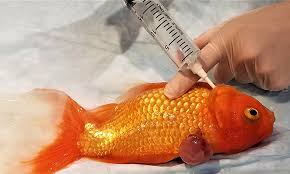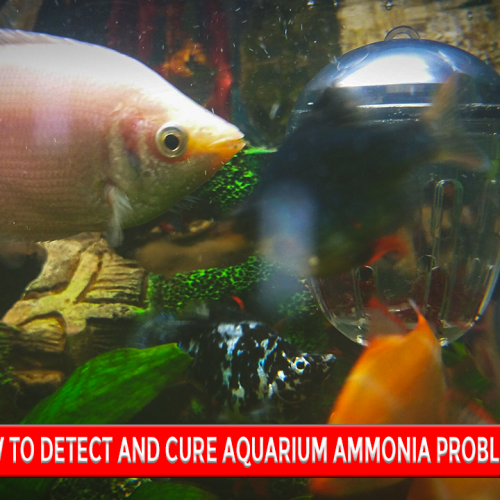Gas Bubble Disease in Fish
Gas Bubble Disease (GBD) is a rare yet serious condition affecting fish in aquariums, ponds, and natural water systems. It occurs when excessive dissolved gases in the water lead to bubble formation in a fish’s tissues, skin, or blood vessels. Without prompt treatment, GBD can cause significant harm or even be fatal. This guide explores the causes, symptoms, treatment, and prevention of this condition.
What Causes Gas Bubble Disease?
 The root cause of GBD is the supersaturation of gases (e.g., oxygen and nitrogen) in the water. When water holds more dissolved gases than it can naturally accommodate, the excess gases form bubbles inside fish tissues.
The root cause of GBD is the supersaturation of gases (e.g., oxygen and nitrogen) in the water. When water holds more dissolved gases than it can naturally accommodate, the excess gases form bubbles inside fish tissues.
- Common causes include: Faulty Equipment: Malfunctioning water pumps, filters, or aeration systems that introduce air at high pressure.
- Cold Water Heating: Cold water absorbs more gas. When heated rapidly, the gas is released, and it causes supersaturation.
- Water System Issues: Leaks or damage in plumbing can introduce excess air to the water.
- Over-Aeration: Too much use of air stones or strong aeration devices can cause supersaturation.
Symptoms of Gas Bubble Disease
Early detection of GBD is critical to the treatment’s success. The following symptoms should be detected:
- Visible Bubbles: Gas bubbles trapped beneath the skin, within the fins or eyes.
- Abnormal SwimmZing: Swimming erratically or unable to maintain buoyancy or exhibits signs of stress
- Physical abnormalities: swelling, lesions, or discoloration within the affected regions
- severe cases; unable to swim or appears inert
Treatment of Gas Bubble Disease
Reduce supersaturation:
Turn off, or switch off some, aeration equipment for some time.
- Water Cycles: Change 30-50% of the water by using fresh, well-conditioned water to stabilize the gases.
- De-gas Water: Leave the water to stand for several hours before being used in the tank.
Oxygenation - Utilize a surface skimmer or low-level aeration to ensure balanced oxygen transfer without causing supersaturation.
Quarantine Infected Fish
Relocate fish that are extremely ill to a quarantine tank that has stabilized water parameters so as to minimize stress and help them recover.
Monitor for Secondary Infections:
Treat any open wounds or lesions with appropriate antibacterial or antifungal medications to prevent complications.
Seek Veterinary Advice:
For advanced cases, consult an aquatic veterinarian for professional guidance or treatment options.
Preventing Gas Bubble Disease
 Prevention is always better than treatment. Follow these tips to avoid GBD in your fish tank:
Prevention is always better than treatment. Follow these tips to avoid GBD in your fish tank:
Maintain Equipment:
Regularly inspect and service water pumps, filters, and aeration systems to prevent malfunctions.
Temperature Control:
Gradually change temperature to avoid sudden degassing of water.
Check Gas Contents:
Use a gas sat meter to ensure the safety of dissolved gases.
Aerate Correctly.
Do not over-aerate the tank. Use air stones, or diffusers to distribute oxygen in the tank avoiding over saturation.
Avoid Crowding:
Too many fishes cause stress and destroy balance in the oxygen levels found in the water.
Perform Water Changes:
Always allow water to stand and stabilize before introducing it to the tank, especially if using cold tap water.
Conclusion
Gas Bubble Disease is a disease that is preventable; it calls for attention in terms of water quality and equipment maintenance. Understanding its causes and taking appropriate measures will protect your aquatic pets from this disease, which is potentially fatal. Regular monitoring and care will ensure the safety and health of the fish to thrive in this environment.
FAQs (frequently-asked questions)
Yes, GBD can affect any fish species, but those in poorly maintained tanks or ponds are more vulnerable.
Recovery time can be a few days with mild cases, but it depends on the severity of the condition and how quickly treatment begins. Even with severe cases, recovery may not be sooner than weeks.
No, the disease is not contagious in nature. It is based on environmental factors rather than pathogens.
Though plants and invertebrates are less vulnerable, they may be impacted by the quality of water or higher levels of gases.
Gas saturation meters and trusted kits for water tests would be the weapons needed in keeping the aquarium healthy.




